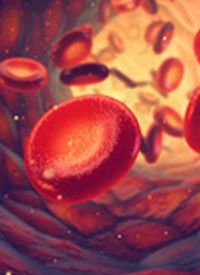Article
Azacitidine/Venetoclax Combo Delivers Promising Early Results in High-Risk CML, MDS
Author(s):
Azacitidine plus venetoclax showed encouraging activity in patients with high-risk myelodysplastic syndromes or chronic myelomonocytic leukemia.

Azacitidine (Onureg) plus venetoclax (Venclexta) showed encouraging activity in patients with high-risk myelodysplastic syndromes (MDS) or chronic myelomonocytic leukemia (CML), according to findings from a phase 1/2 trial (NCT04160052) published in Lancet Haematology.1
Patients (N = 23) received intravenous or subcutaneous 75 mg/m2 azacitidine for 5 days and oral 100 mg to 400 mg venetoclax for 7 to 14 days. In phase 1 results at a median follow-up of 13.2 months (interquartile range, 6.8-18.3), the overall response rate (ORR) was 87% (95% CI 66%–97%).
The maximum tolerated dose (MTD) was not reached. Investigators established the recommended phase 2 dose (RP2D) as 75 mg/m2 azacitidine for 5 days plus 400 mg venetoclax for 14 days.
Venetoclax is a first-in-class agent that selectively binds to and inhibits the BCL2 protein, which prevents some hematologic cancers from undergoing apoptosis. The agent is approved as a monotherapy for adult patients with chronic lymphocytic leukemia or small lymphocytic lymphoma and in combination with azacitidine, decitabine, or low-dose cytarabine for newly diagnosed acute myeloid leukemia (AML) in adults 75 years or older or with comorbidities that preclude use of intensive induction chemotherapy.
Investigators at the University of Texas MD Anderson Cancer Center enrolled adult patients with treatment-naive or relapsed/refractory high-risk MDS or CML and bone marrow blasts of more than 5% from November 2019 to December 2019. Seventeen patients (74%) were naïve to hypomethylating agents, and 6 patients (26%) had failed on a hypomethylating agent. Eighteen patients (78%) were male, 21 patients (91%) were White, and 2 patients (9%) were Asian.
The primary outcome was safety and tolerability. Investigators also sought to determine the MTD and RP2D of the azacytidine/venetoclax combination using a 3 + 3 study design.
The most common grade 3/4 treatment-emergent adverse effects were neutropenia (39%), thrombocytopenia (39%), lung infection (30%), and febrile neutropenia (17%). Investigators reported 3 deaths due to sepsis during the study, none of which were related to the treatment.
In July 2021, the FDA granted breakthrough therapy designation (BTD) to azacytidine/venetoclax combination or the treatment of adult patients with previously untreated intermediate-, high- and very high-risk MDS per the revised International Prognostic Scoring System (IPSS-R).2
Results from the phase 1b M15-531 study (NCT02942290) supported the BTD. M15-531 is an ongoing study investigating the safety and pharmacokinetics of venetoclax plus azacitidine in approximately 137 patients with treatment-naïve, higher-risk MDS. The study was initiated to address the short median overall survival (OS) of the population, which is about 18 months.3
The co-primary end points include area under the curve for both agents, maximum plasma concentration, time of maximum plasma concentration, half-life for azacitidine, clearance for azacitidine, and the RP2D.
Treatment with venetoclax plus azacitidine induced an ORR of 77%, which included complete responses (CR) in 42% and marrow CRs in 35%. Of the patients who achieved a CR, 40% had CR with hematological improvement. Responses lasted for a median duration of 14.8 months (95% CI, 12.9–not estimable [NE]). The median OS was not reached (95% CI, 16.2-NE). The median progression-free survival was 17.5 months (95% CI, 14.5-NE).
The analysis included 57 patients followed for a median of 13.0 months (95% CI, 11.3-15.6). The population was largely male (75%) and had a median age of 71 years (range, 26-85 years). Additionally, 89% of patients had an ECOG performance status of 0 or 1.
In April 2022, the FDA removed a partial clinical hold on the phase 3 ENHANCE trial (NCT04313881) evaluating magrolimab plus azacitidine vs azacitidine plus placebo in untreated patients with MDS and AML.4 The agency paused the study in January 2022 because of an apparent imbalance in investigator-reported, suspected unexpected serious adverse reactions. Although no clear trend in toxicities or new safety signals had been observed by the company at the time, the hold was placed on all ongoing studies that were evaluating the combination on a global scale.
References
- Bazinet A, Darbaniyan F, Jabbour E, et al. Azacitidine plus venetoclax in patients with high-risk myelodysplastic syndromes or chronic myelomonocytic leukaemia: phase 1 results of a single-centre, dose-escalation, dose-expansion, phase 1-2 study. Lancet Haematol. 2022:S2352-3026(22)00216-2. doi:10.1016/S2352-3026(22)00216-2
- FDA grants breakthrough therapy designation for Venclexta in combination with azacitidine for the treatment of patients with myelodysplastic syndromes. News release. July 21, 2021. Accessed September 7, 2022. https://bit.ly/3eGvlF2
- Garcia JS, Wei AH, Borate U, et al. Safety, efficacy, and patient-reported outcomes of venetoclax in combination with azacitidine for the treatment of patients with higher-risk myelodysplastic syndrome: a phase 1b study. Blood. 2020;136(suppl 1):55–57. doi:10.1182/blood-2020-139492
- FDA lifts partial clinical hold on MDS and AML magrolimab studies. News release. Gilead Sciences, Inc. April 11, 2022. Accessed September 7, 2022. https://bit.ly/3x2uNT8









